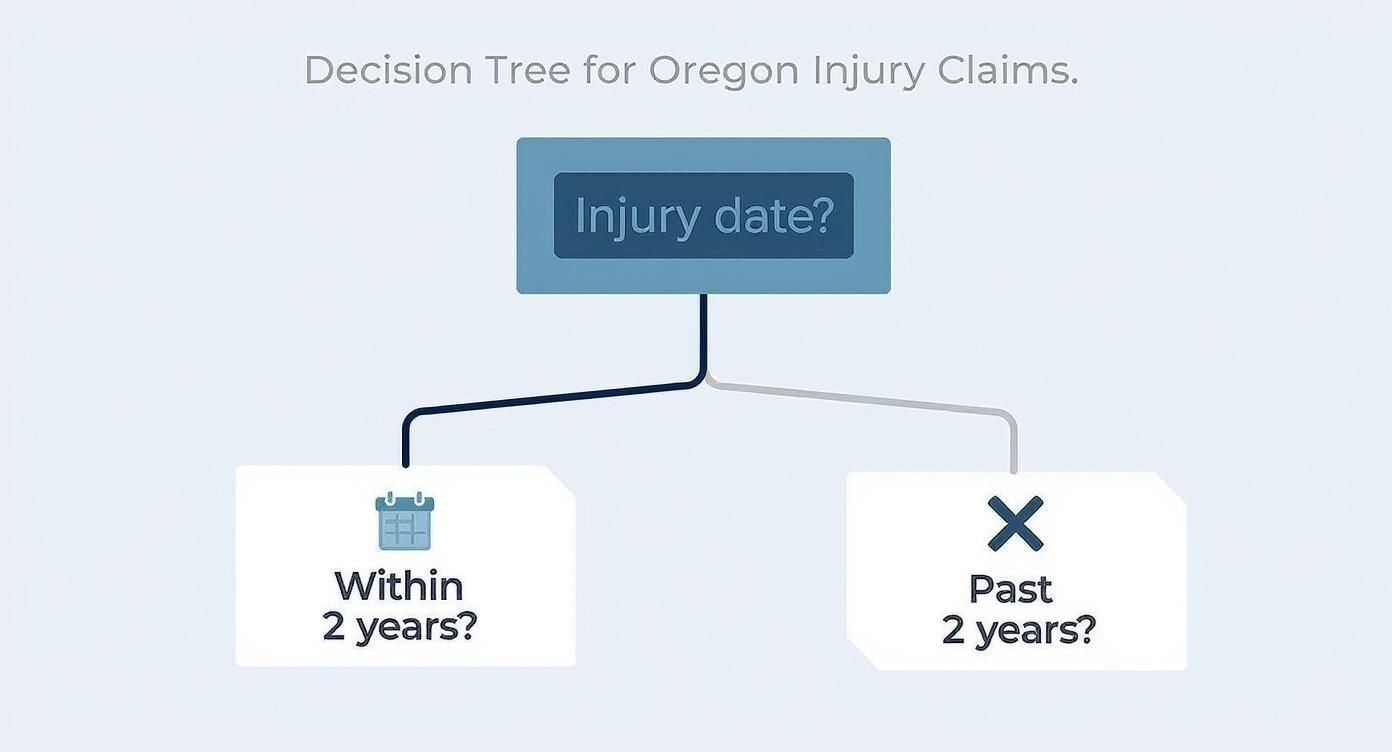Oregon personal injury statute of limitations: Key deadlines
"I was satisfied once John Bell took over my case."
"Communication was always timely."
Oregon personal injury statute of limitations: Key deadlines
In Oregon, you generally have just two years from the date of your injury to file a lawsuit. This isn't just a suggestion—it's a hard deadline known as the statute of limitations. Think of it as a countdown clock on your right to seek compensation, and once it hits zero, your chance to get justice is usually gone for good.
The Ticking Clock on Your Right to Compensation
The Oregon personal injury statute of limitations is a non-negotiable legal countdown. The whole point is to make sure people bring their claims forward while evidence is still fresh and memories haven't faded. It prevents cases from dragging on forever, which would be unfair to everyone involved.
For anyone who's been hurt, this deadline is probably the single most important rule in the entire legal process. It doesn't matter how badly you were injured or how obvious it is that someone else was at fault. If you miss this filing window, the courthouse doors will almost certainly be locked to you forever.
Why This Deadline Is So Critical
Getting a handle on this two-year rule is the first and most vital step to protecting your rights after an accident. It covers most of the common ways people get hurt.
- Car, truck, and motorcycle accidents: The vast majority of crashes fall squarely under this two-year deadline.
- Slip and fall incidents: If you're injured on someone else's property because of their negligence, the same time limit applies.
- Dog bites and animal attacks: These claims also need to be filed within the standard two-year period.
The law is crystal clear. Oregon statutes say that a personal injury lawsuit has to be filed within two years from the date the injury happened. So, whether you were hurt in a fall or a fender bender, the clock starts ticking the moment the accident occurs. You can learn more about the specifics of Oregon's statutory deadlines.
The statute of limitations isn't a guideline; it's a rigid legal barrier. Missing it by even a single day can mean losing your right to financial recovery forever.
This strict enforcement is exactly why you need to act quickly after an injury. Building a strong case takes time—you have to investigate, gather evidence, and prepare all the legal paperwork. Starting the process long before the deadline is not just a good idea, it's essential.
To make things clearer, here's a quick look at the standard deadlines for different types of injury-related claims in Oregon.
Oregon Personal Injury Claim Deadlines at a Glance
This table provides a quick summary of the standard filing deadlines for different types of injury-related claims in Oregon.
| General Personal Injury (e.g., car accidents, slip and falls) | 2 Years from the date of injury |
| Medical Malpractice | 2 Years from the date the injury was discovered (or should have been) |
| Wrongful Death | 3 Years from the date of injury that caused the death |
| Product Liability | 2 Years from the date of injury or discovery |
| Claims Against a Government Entity | 180 Days to provide a tort claim notice |
Keep in mind that while these are the standard timeframes, some exceptions can change the deadline. It's always best to consult with an attorney to understand the specific timeline for your situation.
Pinpointing When Your Two-Year Countdown Actually Begins
You might hear you have two years to file a personal injury claim, but that’s only half the story. The real question is: when does that two-year clock actually start ticking? It's not always on the day of the accident itself, and this is where things can get a bit tricky.
The start date is governed by a legal concept in Oregon called the discovery rule. Think of it this way: you can't be expected to act on an injury you don't even know you have. It would be like trying to fix a slow leak in a pipe that's hidden behind a wall—you can't address the problem until you see the water stain.
The law works in a similar, common-sense way. It recognizes that it’s simply not fair to penalize someone for not filing a claim for an injury they weren't aware of yet.
Under the discovery rule, Oregon's two-year statute of limitations starts on the date you either discovered your injury or, through reasonable care, should have discovered it.
When Discovery Determines Your Deadline
This rule is a game-changer in cases where the harm isn't immediately obvious. A straightforward car crash is one thing, but many injuries have a delayed fuse. For instance, figuring out your filing deadline after an auto accident can be surprisingly complex if your injuries don't show up for days or even weeks. Determining your filing deadline after an auto accident is a critical step, as these hidden injuries are more common than people think.
Here are a few classic scenarios where the discovery rule is front and center:
- Medical Malpractice: A patient feels "off" for months after surgery. It's only when they get a second opinion that an X-ray reveals a surgical sponge was left inside them. The clock starts when the sponge is found, not on the day of the surgery.
- Toxic Exposure: Someone works around chemicals for years without issue. A decade later, they develop a rare lung condition. A specialist eventually traces the illness directly back to that workplace exposure. The countdown begins when that connection is made.
- Delayed-Onset Injuries: You're in a minor fender-bender and walk away feeling just a little shaken. A month later, you start having persistent headaches and memory fog, leading to a diagnosis of a traumatic brain injury. Your two years would start from that diagnosis, not the date of the crash.
In all these examples, the stopwatch for filing a lawsuit didn't begin on the day of the incident. It started on the day the person finally understood the true nature and cause of their harm.
This chart breaks down the fundamental starting points for your claim's timeline.

As you can see, the "date of injury" is the first and most important piece of the puzzle. It sets the baseline for whether you're safely within that standard two-year window.
But be warned: the phrase "reasonably should have known" can become a major battleground. The at-fault party's insurance company might argue that you should have gone to the doctor sooner or connected the dots earlier, all in an attempt to claim your deadline has passed. Because this date can be subjective and is often disputed, the smartest move is to talk to an experienced attorney. They can help you establish your official discovery date and ensure your right to seek compensation is protected.
Navigating Deadlines for Specific Injury Claims
It’s easy to hear about the "two-year rule" and think you have plenty of time, but that's a dangerous assumption to make in a personal injury case. The Oregon personal injury statute of limitations isn't a one-size-fits-all deadline. Different types of injuries and different defendants come with their own unique timelines.
Knowing which clock you're racing against is absolutely essential. Get it wrong, and you could lose your right to compensation before you even get started.
For many of the most common incidents, that two-year deadline does hold true. This generally applies to cases involving:
- Car, truck, and motorcycle accidents
- Slip and fall incidents on someone else's property
- Dog bites and other animal attacks
In these situations, the clock usually starts ticking the moment the injury occurs. But this is just the starting point. Several critical exceptions have entirely different deadlines that you cannot afford to miss.
Key Exceptions to the Two-Year Rule
Not every injury claim fits neatly into that two-year box. Oregon law carves out specific timelines for more complex or severe situations.
Wrongful Death Claims
When someone's negligence leads to a death, the law recognizes that the family needs more time. For wrongful death claims, Oregon provides a three-year statute of limitations. This clock starts running from the date of the injury that ultimately caused the death, giving the family a bit more breathing room to grieve and prepare a legal case.
Product Liability Cases
What happens if you're hurt by a faulty product? While the two-year rule is the general guide, Oregon's "discovery rule" often comes into play here. This means your deadline might not start when the injury first happened, but on the day you discovered—or reasonably should have discovered—that the defective product was the cause of your harm.
Strict Deadlines for Claims Against the Government
This is one of the biggest traps in Oregon personal injury law. If your injury was caused by a government entity—like a city bus, a state employee, or a poorly maintained public sidewalk—the rules change completely. You can't just wait and file a lawsuit within two years.
Before you can even think about a lawsuit, you must give the correct government agency a formal tort claim notice. You only have 180 days from the date of injury to do this. For a wrongful death claim against the government, that notice period is extended to one year.
Miss this short notice window, and your case is almost certainly over, no matter how strong it is. It's a strict, unforgiving deadline. This is why understanding the specific requirements for your bodily injury claim is so critical when a government body is involved.
The pressure to act quickly is real. Complex cases, especially those with severe injuries or difficult insurance companies, take a long time to build. That two-year statute of limitations can shrink surprisingly fast, putting all the pressure on the injured person to get the ball rolling immediately.
Circumstances That Can Pause the Legal Clock

While the Oregon personal injury statute of limitations feels like a hard and fast rule, it isn't always set in stone. The law carves out a few very specific situations where the countdown can be put on hold. This legal concept is known as tolling, and it’s a built-in fairness mechanism for people who, for one reason or another, simply can’t file a lawsuit.
Think of your two-year deadline as a stopwatch. Tolling is like hitting the pause button. The time that has already run is locked in, but the clock stops ticking until the situation is resolved. It’s a critical protection, but I have to stress that these exceptions are rare and apply narrowly. You should never assume your case qualifies without first speaking with an attorney.
When Someone Lacks Legal Capacity to Sue
Sometimes, an injured person isn't legally able to bring a lawsuit on their own behalf. In these cases, Oregon law recognizes it wouldn't be fair to let the clock run out. The statute of limitations is tolled to give them a fair shot at justice down the road.
Two of the most common scenarios involve:
- Injured Minors: If a child under 18 is injured, the clock doesn't start ticking against them. Instead, the deadline is paused until their 18th birthday, giving them the chance to decide as a legal adult whether to pursue a claim.
- Mental Incapacity: Similarly, if an injury leaves someone mentally unable to understand their rights or manage their affairs, the deadline can be paused. This tolling period usually lasts until they are deemed legally competent again.
These protections ensure that Oregon's justice system balances efficiency with the fundamental rights of injured people. For a closer look at the specifics, you can explore more about Oregon's legal timelines for personal injury claims.
Important Note: Courts interpret these exceptions very strictly. The burden falls entirely on the injured person to prove why their deadline should be extended.
When the At-Fault Party Disappears
What happens if you can’t find the person you need to sue? The legal system accounts for this, too. After all, it's not fair if someone can escape responsibility just by hiding.
If a defendant leaves Oregon or goes into hiding specifically to avoid being served with a lawsuit, the law may pause the Oregon personal injury statute of limitations. The clock stops for the entire time they are out of state or can't be found through reasonable effort.
This rule prevents a negligent person from gaming the system by simply running out the clock. Once they're located or return to the state, the stopwatch starts ticking again right where it left off.
The High Cost of Missing Your Filing Deadline
Imagine holding a winning lottery ticket, only to find it in a coat pocket months after the prize claim deadline has passed. That ticket, once worth a fortune, is now just a worthless piece of paper. The Oregon personal injury statute of limitations is just as unforgiving.
Missing this deadline is one of the most critical errors you can make in your case. It’s not a soft suggestion or a guideline the court might overlook; it's a hard-and-fast rule. Fail to file your lawsuit before the clock runs out, and the door to seeking compensation slams shut for good.
The Point of No Return
Think of the statute of limitations as a legal point of no return. You might have an airtight case—piles of medical bills, clear proof the other party was at fault, and documentation of all your lost wages and suffering. But none of that matters once the deadline has passed.
The moment that date comes and goes, your legal right to sue evaporates. The defendant’s attorney won’t even need to argue the facts of the case. They will simply file a motion to dismiss based on the missed deadline, and the judge will have no choice but to throw your case out. It's an irreversible outcome that strips you of your only chance to hold the negligent party accountable.
Missing the statute of limitations isn't a minor setback—it's the end of your legal journey. The law makes no exceptions for strong cases filed late.
This is precisely why waiting is so risky. The legal system is built to encourage people to act promptly, and the penalty for delay is absolute. The single best way to protect your rights is to speak with an experienced personal injury attorney as soon as possible. They can determine your exact filing deadline, handle the complicated procedural steps, and make sure your claim is filed in time, keeping your path to justice open.
Actionable Steps to Protect Your Injury Claim Today

Knowing about the Oregon personal injury statute of limitations is one thing, but what you do right after an accident is what truly sets the stage for a successful claim. Those first few days and weeks are absolutely critical—they can make or break your chances of getting the compensation you deserve.
This isn't a "wait and see" situation. Evidence has a way of vanishing, people's memories get fuzzy, and that legal clock is always ticking in the background. You need to start building your case from day one.
Your Immediate Action Plan
To protect your legal options, you have to get proactive right away. Your goal is to build a clear, comprehensive record of what happened, who was involved, and how the injury has turned your life upside down.
Here are the first things you should do:
Get Medical Help Immediately: Your well-being is always the top priority. Going to a doctor or the emergency room right away starts your treatment and, just as importantly, creates an official medical record connecting your injuries directly to the incident.
Collect Evidence at the Scene: If you're physically able, use your phone to take pictures and videos of everything—the scene, your injuries, vehicle damage, and anything else that seems relevant. Get the names and phone numbers of anyone who saw what happened.
Keep Detailed Records: Start a simple journal. Write down your pain levels, doctor's visits, missed work days, and any daily activities you can no longer do. Keep a folder for every single bill, receipt, and letter related to the accident.
This initial groundwork is priceless. For instance, knowing exactly what to do immediately after a car accident injury can ensure you don't overlook a small but crucial piece of evidence.
The Most Important Step You Can Take
While gathering evidence yourself is smart, there’s one move that protects you from a missed deadline more than any other: talking to a personal injury lawyer. The insurance adjuster might sound friendly on the phone, but their job is to pay out as little as possible for their company. They are not your advocate.
The single most effective way to protect your rights and navigate the Oregon personal injury statute of limitations is to seek legal counsel immediately. An attorney works for you, not the insurance company.
A good attorney will immediately calculate your specific filing deadline, launch a proper investigation, and take over all the frustrating phone calls with the insurance company. This frees you up to focus on what really matters—getting better—without the constant worry of your legal rights slipping away. We have another guide that explains when to hire a personal injury attorney to handle these kinds of complex legal deadlines for you.
Got Questions? We've Got Answers
The legal world can feel like a maze of confusing rules and deadlines. To help clear things up, here are some straight answers to the questions we hear most often about Oregon’s personal injury statute of limitations.
Does Talking to an Insurance Adjuster Stop the Clock?
No, it absolutely does not. This is a huge mistake people make, and it can be a costly one.
Simply being in talks with an insurance company—even if they seem friendly and a settlement feels close—has zero effect on your legal deadline. The only thing that officially protects your right to compensation is filing a lawsuit in court before that two-year window closes. Don't let an adjuster's promises lull you into missing your chance to file.
What if My Child Was Injured?
The rules are different when a child is hurt. For minors, Oregon law “tolls,” or pauses, the statute of limitations clock. This pause lasts until the child either turns 18 or is legally emancipated.
Once they become a legal adult, a new clock starts. They typically have one year to file a lawsuit, but the total time from the date of the injury can't be more than five years. This gives young people a fair opportunity to pursue justice for themselves once they're old enough.
My Injuries Didn't Show Up Right After My Car Accident. When Does My Deadline Start?
This is a perfect example of Oregon’s “discovery rule” in action. It's common for injuries, like whiplash or a herniated disc, to pop up days or even weeks after an accident.
If your injury wasn't something you could have reasonably known about right away, your two-year clock might start on the day you discovered it—or should have discovered it. For example, if a doctor diagnoses a serious back injury a month after your fender-bender and ties it directly to the crash, your deadline would likely start from the date of that diagnosis. Proving this can be tricky, so getting a lawyer's advice is crucial to pinpoint your exact start date.
Trying to manage these deadlines while you're recovering from an injury is a heavy burden. You don't have to carry it by yourself. The experienced team at Bell Law is here to make sure your case is filed on time and your rights are protected. Get in touch with us for a free consultation.







